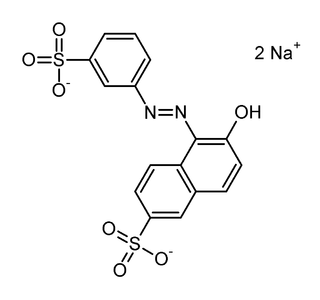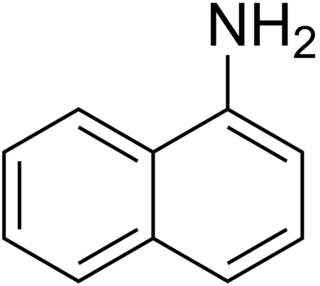
Orange GGN, also known as alpha-naphthol orange, is an azo dye formerly used as a food dye. It is the disodium salt of 1-(m-sulfophenylazo)-2-naphthol-6-sulfonic acid. In Europe, it was denoted by the E Number E111, but has been forbidden for use in foods since 1 January 1978. It has never been included in the food additives list of the Codex Alimentarius. As such, it is forbidden for food use in general, because toxicological data has shown it is harmful.

Congo red is an organic compound, the sodium salt of 3,3′-([1,1′-biphenyl]-4,4′-diyl)bis(4-aminonaphthalene-1-sulfonic acid). It is an azo dye. Congo red is water-soluble, yielding a red colloidal solution; its solubility is greater in organic solvents. The use of Congo red in the textile industry has long been abandoned, primarily because of its carcinogenic properties, but it is still used for histological staining.

Azo compounds are organic compounds bearing the functional group diazenyl.

Sudan I is an organic compound, typically classified as an azo dye. It is an intensely orange-red solid that is added to colourise waxes, oils, petrol, solvents, and polishes. Sudan I has also been adopted for colouring various foodstuffs, especially curry powder and chili powder, although the use of Sudan I in foods is now banned in many countries, because Sudan I, Sudan III, and Sudan IV have been classified as category 3 carcinogens by the International Agency for Research on Cancer. Sudan I is still used in some orange-coloured smoke formulations and as a colouring for cotton refuse used in chemistry experiments.

An acid dye is a dye that is typically applied to a textile at low pH. They are mainly used to dye wool, not cotton fabrics. Some acid dyes are used as food colorants, and some can also be used to stain organelles in the medical field.

Para red is a dye. Chemically, it is similar to Sudan I. It was discovered in 1880 by von Gallois and Ullrich and was the first azo dye. It dyes cellulose fabrics a brilliant red color, but is not very fast. The dye can be washed away easily from cellulose fabrics if not dyed correctly. Acidic and basic stages both occur during the standard formation of Para Red, and acidic or basic byproducts may be present in the final product.

Azo dyes are organic compounds bearing the functional group R−N=N−R′, in which R and R′ are usually aryl and substituted aryl groups. They are a commercially important family of azo compounds, i.e. compounds containing the C-N=N-C linkage. Azo dyes are synthetic dyes and do not occur naturally. Most azo dyes contain only one azo group but there are some that contain two or three azo groups, called "diazo dyes" and "triazo dyes" respectively. Azo dyes comprise 60-70% of all dyes used in food and textile industries. Azo dyes are widely used to treat textiles, leather articles, and some foods. Chemically related derivatives of azo dyes include azo pigments, which are insoluble in water and other solvents.
In organic chemistry, an azo coupling is an reaction between a diazonium compound and another aromatic compound that produces an azo compound. In this electrophilic aromatic substitution reaction, the aryldiazonium cation is the electrophile, and the activated carbon, serves as a nucleophile. Classical coupling agents are phenols and naphhthols. Usually the diazonium reagent attacks at the para position of the coupling agent. When the para position is occupied, coupling occurs at a ortho position, albeit at a slower rate.

2-Naphthylamine is one of two isomeric aminonaphthalenes, compounds with the formula C10H7NH2. It is a colorless solid, but samples take on a reddish color in air because of oxidation. It was formerly used to make azo dyes, but it is a known carcinogen and has largely been replaced by less toxic compounds.

1-Naphthylamine is an aromatic amine derived from naphthalene. It can cause bladder cancer. It crystallizes in colorless needles which melt at 50 °C. It possesses a disagreeable odor, sublimes readily, and turns brown on exposure to air. It is the precursor to a variety of dyes.

Sulfanilic acid (4-aminobenzenesulfonic acid) is an organic compound with the formula H3NC6H4SO3. It is an off-white solid. It is a zwitterion, which explains its high melting point. It is a common building block in organic chemistry.
Azobenzene reductase also known as azoreductase (EC 1.7.1.6) is an enzyme that catalyzes the chemical reaction:

Acid red 88 is an azo dye. Due to its intense colour, solid samples appear almost black. It is used to dye cotton textiles red. A closely related acid dye is Acid Red 13.

Naphthionic acid is an organic compound with the formula C10H6(SO3H)(NH2). It is one of several aminonaphthalenesulfonic acids, derivatives of naphthalene containing both amine and sulfonic acid functional groups. It is a white solid, although commercial samples can appear gray. It is used in the synthesis of azo dyes such as Rocceline (a. k. a. Solid Red A), during which the amino group of the acid (in the form of a salt) is diazotated and then coupled with, in the case mentioned, β-naphthol. It is prepared by treating 1-aminonaphthalene with sulfuric acid.

Disodium 4,4′-dinitrostilbene-2,2′-disulfonate is an organic compound with the formula (O2NC6H3(SO3Na)CH)2. This salt is a common precursor to a variety of textile dyes and optical brighteners
Xenophilus azovorans is a bacterium from the genus Xenophilus which has been isolated from soil in Switzerland.

Naphthol AS is an organic compound with the formula C10H6(OH)C(O)NHC6H5. It is the anilide of 3-hydroxy-2-carboxynaphthalene. Many analogous compounds are known, designated with a differing suffix. For example, in Naphthol AS-OL, the aryl substituent on nitrogen is C6H4-2-OCH3. These compounds are used as coupling partners in the preparation of some azo dyes.

3-Hydroxy-2-naphthoic acid is an organic compound with the formula C10H6(OH)(CO2H). It is one of the several hydroxynaphthoic acids. It is a precursor to some azo dyes and pigments. It is prepared by carboxylation of 2-naphthol by the Kolbe–Schmitt reaction.

Metal-complex dyes are a family of dyes that contain metals coordinated to the organic portion. Many azo dyes, especially those derived from naphthols, form metal complexes by complexation of one of the azo nitrogen centers. The insertion of the metal into the organic ligand often involves redox reactions, e.g. pre-reaction of sodium dichromate with glucose. Phthalocyanine (Pc) complexes, such as CuPc, are another important family of metal complex dyes.

Acid orange 19 is an azo dye that is used to color polyamide and wool fibers.


















